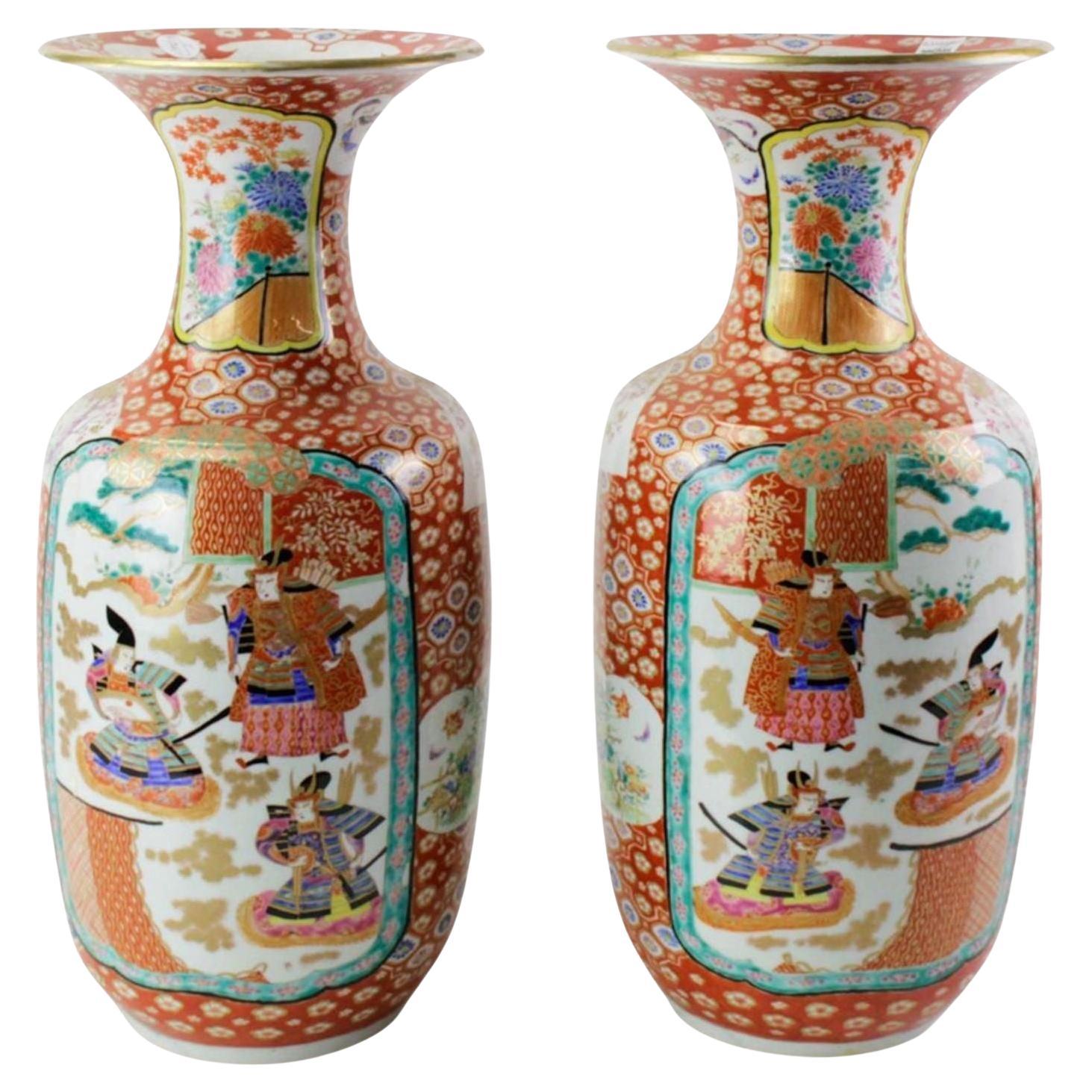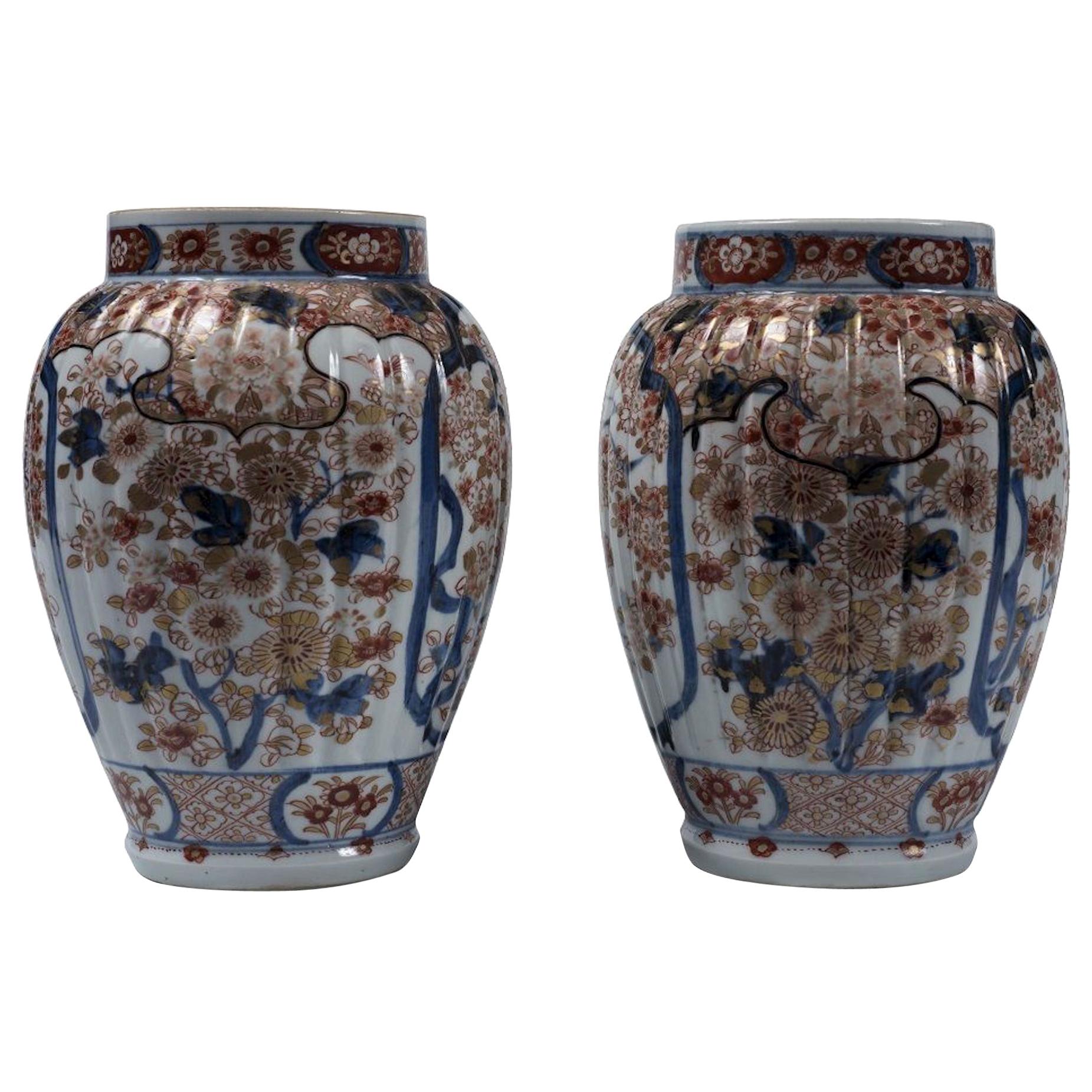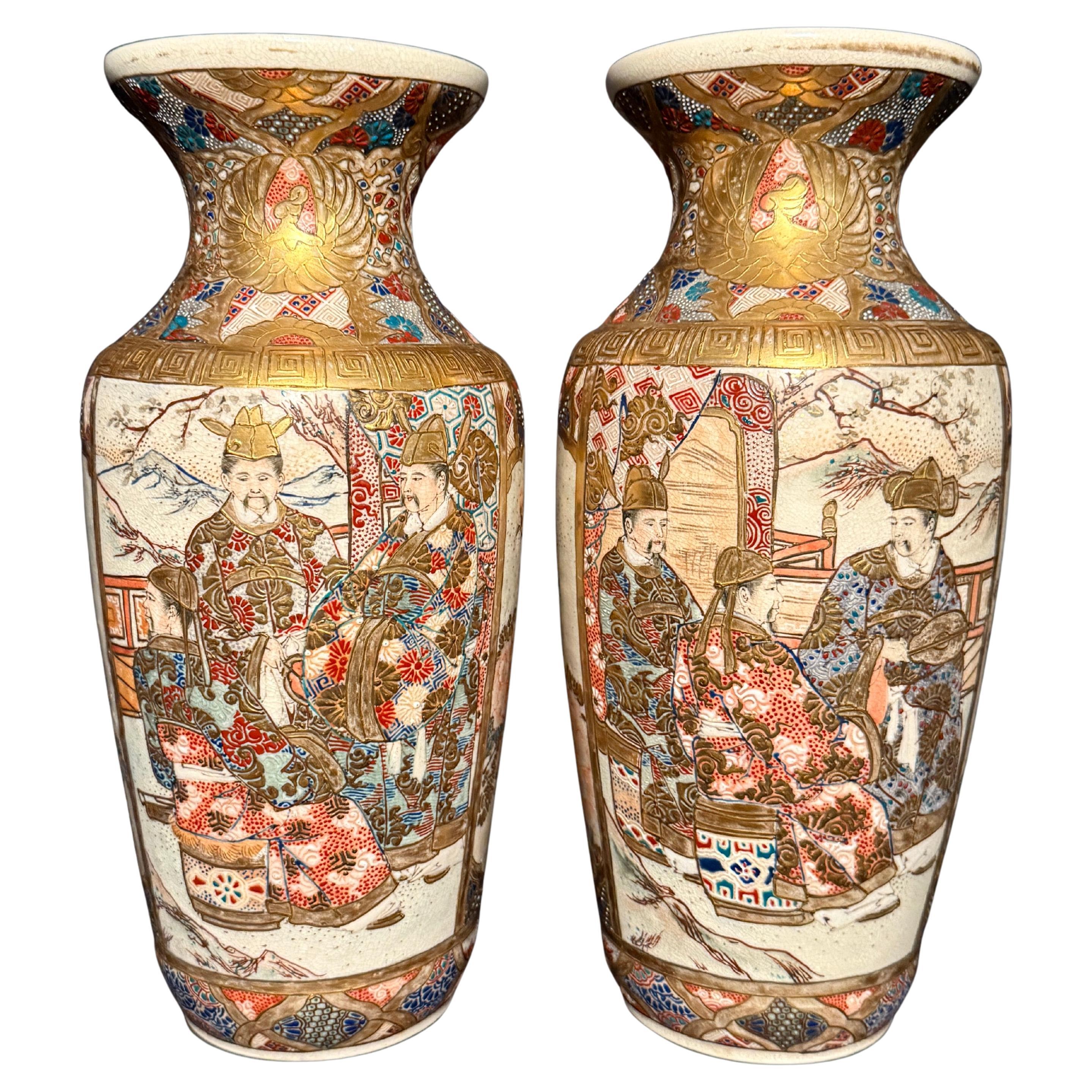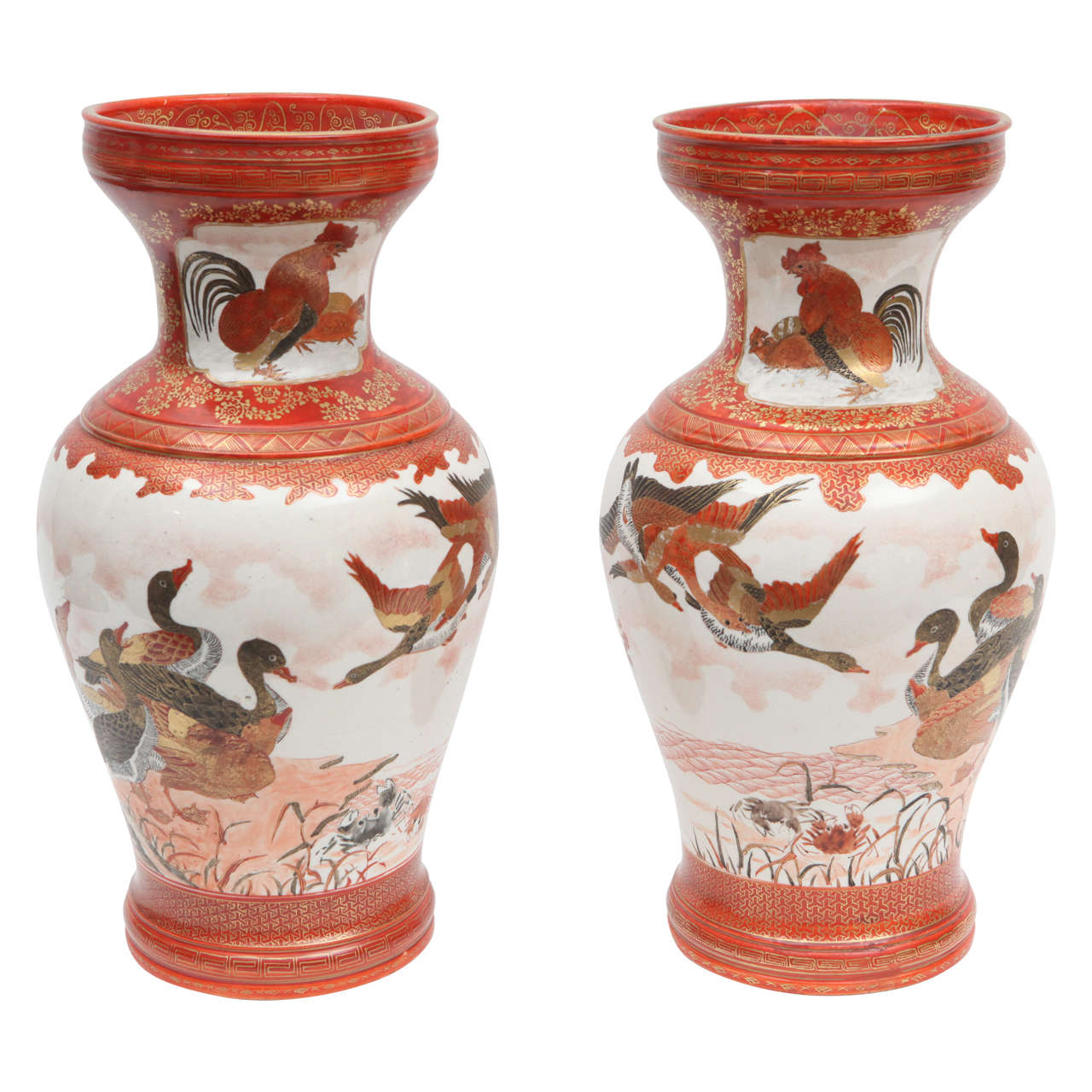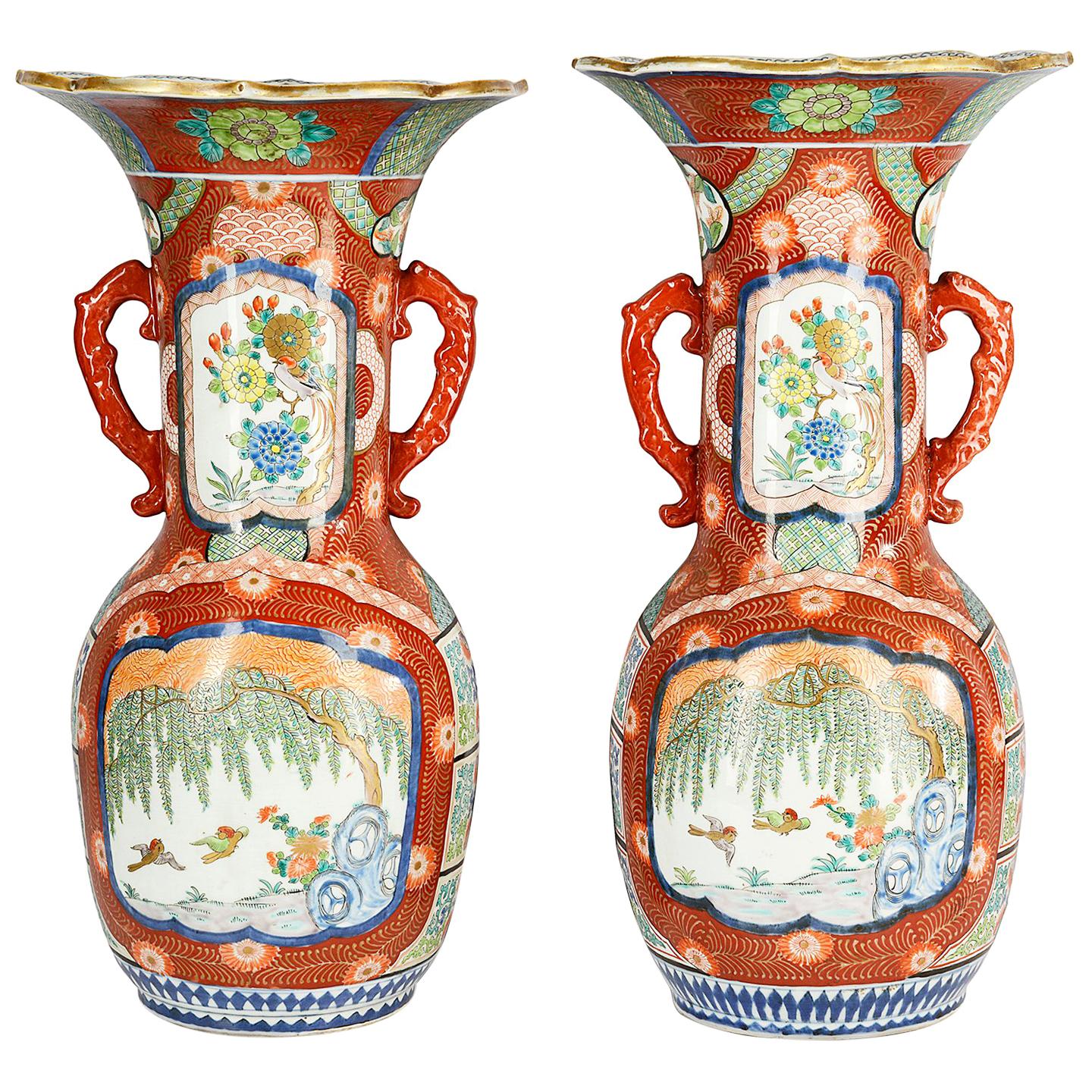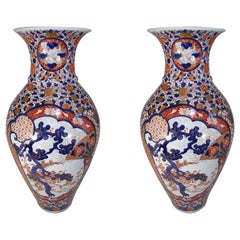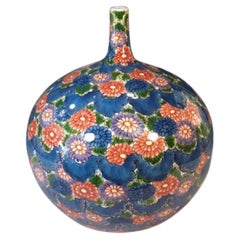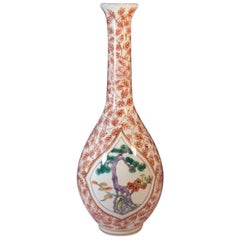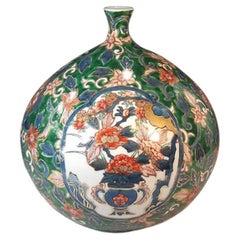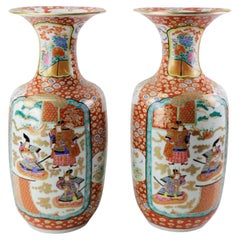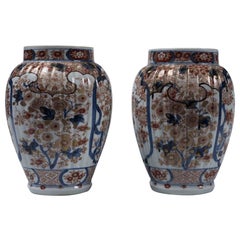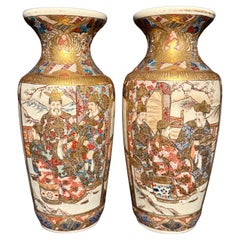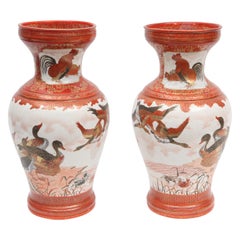Items Similar to Pair of Japanese Late Meiji Period Fukagawa Porcelain Vases, circa 1900
Video Loading
Want more images or videos?
Request additional images or videos from the seller
1 of 15
Pair of Japanese Late Meiji Period Fukagawa Porcelain Vases, circa 1900
$29,500per set
£22,277.22per set
€25,505.37per set
CA$41,661.71per set
A$45,484.62per set
CHF 23,845.72per set
MX$552,428.18per set
NOK 297,794.26per set
SEK 281,197.19per set
DKK 190,370.40per set
About the Item
Superb pair of Japanese large Meiji period Fukagawa signed porcelain vases (circa 1900). Intricately hand-painted in cobalt blue underglaze with polychrome and gold overglaze on a stunning bottle-shaped body featuring an elegant long neck, set against a pure white background that is the characteristic of Imari-Arita porcelain.
The Mt. Fuji and flowing water kiln mark is the signature of the Fukagawa Seiji Company established in 1894 by Chuji Fukagawa, the son of the founder of the famed Koransha Kiln (Scented Orchid Company) created in 1875. Fukagawa Seiji gained worldwide acclaim after winning the Grand Prix in the Paris World Exposition of 1900.
This pair of porcelain vases was created at about the same time as the 1900 Paris World Exposition. They feature scenes from the Nagasaki Dragon Dance Festival (with roots in the 18th century) and showcase a complicated combination of stunning patterns on diamond shape panels. Numerous intricate flower and bird motifs cover other areas of these breathtaking vases. The two porcelain vases are in excellent condition.
The late father of the collector of this exquisite pair, who operated one of the leading kilns in the historic Imari-Arita region of Japan, travelled extensively throughout Europe in the 1960s with a mission that he led to purchase and bring back to Japan antique ceramics that had been exported from Japan to the West over the past 250 years. A total of 104 pieces were acquired and brought back. These were very unique pieces, designed and produced to export to Europe and later to America too, mostly in the 18th up to very early 20th century. These were carefully studied and extensively copied in the hope of creating products that conformed with the long-standing tastes and preferences in the west and bringing back the glory of that era. He concentrated on purchasing massive masterpieces that originated from his region of Imari-Arita. Records show that the mission did a considerable portion of its buying in London. All the 104 pieces have been in his museum quality private collection. This pair of Meiji period porcelain vases (circa 1900) is among these 104 exceptional and unique pieces.
Dimensions: H 13.5 in, D 13.5 in.
- Dimensions:Height: 13.5 in (34.29 cm)Diameter: 13.5 in (34.29 cm)
- Sold As:Set of 2
- Style:Meiji (Of the Period)
- Materials and Techniques:
- Place of Origin:
- Period:1900-1909
- Date of Manufacture:circa 1900
- Condition:Wear consistent with age and use. This set of Meiji porcelain vases is in perfect condition. There are no cracks, chips or restorations.
- Seller Location:Takarazuka, JP
- Reference Number:Seller: CVSD1stDibs: LU2771324034212
About the Seller
5.0
Vetted Professional Seller
Every seller passes strict standards for authenticity and reliability
Established in 2009
1stDibs seller since 2017
231 sales on 1stDibs
- ShippingRetrieving quote...Shipping from: Takarazuka, Japan
- Return Policy
Authenticity Guarantee
In the unlikely event there’s an issue with an item’s authenticity, contact us within 1 year for a full refund. DetailsMoney-Back Guarantee
If your item is not as described, is damaged in transit, or does not arrive, contact us within 7 days for a full refund. Details24-Hour Cancellation
You have a 24-hour grace period in which to reconsider your purchase, with no questions asked.Vetted Professional Sellers
Our world-class sellers must adhere to strict standards for service and quality, maintaining the integrity of our listings.Price-Match Guarantee
If you find that a seller listed the same item for a lower price elsewhere, we’ll match it.Trusted Global Delivery
Our best-in-class carrier network provides specialized shipping options worldwide, including custom delivery.More From This Seller
View AllPair of Porcelain Vases Japanese, Circa 1800 Blue Red Gold
Located in Takarazuka, JP
Exquisite pair of mid Edo period large Japanese Ko-Imari porcelain vases in an attractive baluster shape boasting intricate patterns of floral and highly detailed geometric motifs that beautifully intertwine on the body of the handsome vases, creating captivating landscapes in dark blue, orange and gold details throughout, which is characteristic of Imari porcelain from the Edo Period.
The two scalloped cartouches on each vase with highly decorated and elaborate borders recreate the pine, plum and bamboo motif known as “Sho-Chiku-Bai” or the “Three Friends of Winter.”
The impressive pine trees in cobalt blue decorated with gold details dominate the landscape on white background. The two small delicately scalloped cartouches appearing in the middle of the long neck of the vases depict playful rabbits among trees.
The late father of the collector of this exquisite pair, who operated one of the leading kilns in the historic Imari-Arita region of Japan, travelled extensively to Europe in the early 1960s with a mission that he led, to purchase and bring back to Japan antique ceramics...
Category
Antique Early 19th Century Japanese Edo Ceramics
Materials
Gold
Porcelain Vase by Japanese Master Artist
Located in Takarazuka, JP
Exquisite Japanese contemporary porcelain decorative vase, hand painted in vivid blue and red on an elegant bottle shape body, a signed piece by highly acclaimed Japanese master porc...
Category
21st Century and Contemporary Japanese Meiji Vases
Materials
Gold
Japanese White Red Green Porcelain Vase by Contemporary Master Artist
Located in Takarazuka, JP
Exquisite contemporary Japanese porcelain decorative vase hand painted in red, white and green on a beautifully shaped body, a signed work by highly acclaimed Japanese master porcela...
Category
21st Century and Contemporary Japanese Meiji Vases
Materials
Porcelain
Japanese Contemporary Red Green Gold Porcelain Vase by Master Artist, 3
Located in Takarazuka, JP
Exquisite contemporary Japanese porcelain decorative vase, hand painted in red and green with generous gold details on a striking bott...
Category
21st Century and Contemporary Japanese Meiji Vases
Materials
Gold
Japanese Contemporary Green Red Blue Gold Porcelain Vase by Master Artist, 2
Located in Takarazuka, JP
Exceptional Japanese contemporary highly collectible decorative porcelain vase, hand painted in extremely intricate patterns and extensive gold details on vibrant red, yellow, blue/g...
Category
21st Century and Contemporary Japanese Meiji Vases
Materials
Gold
$6,850 Sale Price
45% Off
Japanese Contemporary Green White Blue Porcelain Vase by Master Artist Duo
Located in Takarazuka, JP
Extraordinary Japanese contemporary highly museum quality decorative porcelain vase. This masterpiece is the collaborative work of two brothers and signed by both, highly acclaimed second-generation master porcelain artists of the Imari-Arita region of Japan. The older brother excels in the depiction of breathtaking natural scenes while the younger brother specializes in creating intricate geometric patterns, which in this piece are found in the neck and base of the vase.
It depicts stunning scenes from the famous Japanese Classic literature...
Category
21st Century and Contemporary Japanese Meiji Vases
Materials
Gold
$5,250 Sale Price
44% Off
You May Also Like
Pair of Late 19th Century Japanese Porcelain Vases
Located in Los Angeles, CA
Beautiful pair of Late 19th Century Japanese porcelain vases showcasing a mesmerizing blend of artistic depictions and cultural s...
Category
Antique Late 19th Century Japanese Vases
Materials
Porcelain
Pair of Antique Japanese Porcelain Vases, End of 19th Century
Located in Roma, IT
These Japan porcelain vases are original decorative objects realized in Japan at the end of the 19th century.
Very good conditions.
This refined couple of vases was made by Jap...
Category
Antique Late 19th Century Japanese Vases
Materials
Porcelain
Pair Of Japanese Meiji Period Satsuma Vases
Located in Norwood, NJ
Find pair of Meiji period Japanese Satsuma 4 panel vases. Each vase featuring one panel with scholars and one panel with samurai. The two side panels are floral. Wonderfully gilt and...
Category
Early 20th Century Japanese Meiji Vases
Materials
Ceramic
$1,875 / set
Pair of 19th Century Japanese Porcelain Kutani Vases
Located in Los Angeles, CA
Pair of late 19th century Japanese hand-painted and gilded porcelain kutani vases. These vases are signed.
Category
Antique 19th Century Japanese Ceramics
Materials
Porcelain
Large Pair Meiji Period Japanese Kutani Vases
Located in Brighton, Sussex
A very decorative and impressive Meiji period (1868-1912) Japanese Kutani flare necked twin handle vases. Each with orange ground feather decoration, inset painted panels with blosso...
Category
Antique 19th Century Japanese Vases
Materials
Porcelain
$5,235 / set
Large Pair of 19th Century Japanese Arita Porcelain Vases
Located in Brighton, Sussex
A good quality pair of large 19th century Japanese flared neck Arita vases, each with lacquered panels depicting scenes of two girls in the garden, ...
Category
Antique Late 19th Century Japanese Vases
Materials
Porcelain
More Ways To Browse
Japan 1900
18th Century Blue White Vase
Paris Porcelain Gold And White
Hand Painted Antique Japanese Vases
Blue And White Vase With Birds
Pair Of Blue And Gold Porcelain Vases
18th Century Porcelain Gold Vases
Japanese Blue And White Porcelain Bird
Japanese 20th Century Blue White Vase
18th Century Japanese Porcelain Vases
1900 Japanese Vase
Japanese Imari Vase 18th Century
Japanese Blue And White Bottle Vase
Circa 1900 Japanese Vase
Japanese Fukagawa
Japanese Fukagawa Porcelain
Meiji Fukagawa
Antique Fukagawa Vase
